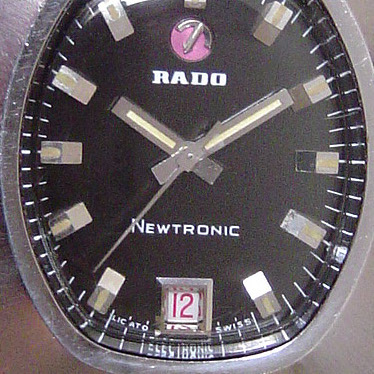RADO Watches
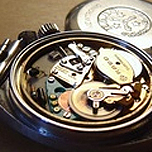
Brand: Rado
Model: Newtronic
Ref. 11900
Case: Stainless steel with screw-back
Bracelet: n/a
Movement: ESA 9154 Dynotron - 13-jewel battery-powered electro-mechanical with balance wheel. Battery bridge signed "Rado"
Description: Newtronic is an early electro-mechanical Rado model introduced in the late 1960s (see image from a 1969 Japanese product catalogue here) The two watches shown here represent the two known dial versions--silver with horizontal markers and charcoal-grey with radially-aligned wedge hour markers. The crystal has the original Rado anchor emblem in the center. Printed on the dial (see images below) are the brand and model names as well as "LIC. ATO SWISS ELECTRONIC"—a reference to the use of technology owned by the ATO brand of Société des Etablissements Léon Hatot, pioneers in the realm of electric and self-powred timekeeping devices.
The bracelet pictured is not original to the watch and was added for purposes of photography. It is believed that the cases of all newtronics were radially brushed; the silver example below has aparently been polished incorrectly.
Photos: Click for larger images
These watches have been sold.



Brand: Rado
Model: NCC 505
Ref.: 625.3037.4
Issued: 1973-1978
Case: Stainless steel with Rado's NCC-System
Bracelet: Stainless steel with Rado clasp
Movement: This watch has not been opened to determine the caliber, but it is presumably an ETA 2824 or similar
Description: This is a near-mint example of a 1973-1979 NCC 505, the last of the NCC models issued by Rado beginning in 1970. According to anecdotal evidence and a period advertisement from Japan, NCC stands for New Conception Construction*--a new secure method of encasing the movement and dial which provides both shock resistance and protection from the elements. The NCC models were known for having large cases, unusual shapes, and often bold color. This example features a case whose rounded sides and straight top/bottom edges are juxtaposed with a dial whose edges feature the same pattern rotated 90 degrees. The effect is an angular watch which benefits from the softness of a few mild curves; a subtle TV-screen effect is achieved. This watch has a metallic blue dial with thick markers appearing to extend from the rehaut. The various layers, accentuate the depth of the watch which is substantial though, with the flat sapphire crystal and bezel, does not make the overall size of the watch overly cumbersome.
A NOS 22mm bracelet with signed Rado clasp is present on this watch.
*If you are able to provide other documentation of NCC, or a translation of this Japanese advertisement, please This email address is being protected from spambots. You need JavaScript enabled to view it.. For info about and images of an early 1970s NCC 101, click here.
Photos: Click for larger images
This watch has been sold.
For watch articles by C. Bradley Jacobs, visit:
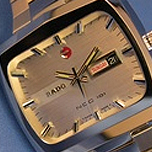

Brand: Rado
Model: NCC 101
Ref.: 11944
Issued: 1970-1972
Case: Stainless steel with Rado's NCC-System
Bracelet: Stainless steel with Rado clasp
Movement: This watch has not been opened to determine the caliber, but it is presumably an ETA 2824 or similar
Description: This is a pristine example of a 1970-1979 NCC 101, the first of the NCC models issued by Rado beginning in 1970. According to anecdotal evidence and a period advertisement from Japan, NCC stands for New Conception Construction*--a new secure method of encasing the movement and dial which provides both shock resistance and protection from the elements. The NCC models were known for having large cases, unusual shapes, and often bold color. This example features a case TV-screen style case with a slight peak at the 12:00 position. This watch has a metallic silver dial with thick markers appearing to extend from the rehaut. The various layers, accentuate the depth of the watch which is substantial though, with the flat sapphire crystal and bezel, does not make the overall size of the watch overly cumbersome.
A 22mm bracelet with signed Rado clasp is present on this watch. Condition of the watch is like new.
*If you are willing to provide other documentation of NCC, or a translation of this Japanese advertisement, please This email address is being protected from spambots. You need JavaScript enabled to view it.. Images of and information about Rado's later NCC 505 model can be found here.
Photos: Click for larger images
This watch has been sold.
For watch articles by C. Bradley Jacobs, visit:
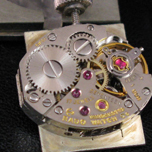
Brand: Rado
Model: Mini Manhattan (ladies' model)
Ref.: 5468
Issued Ca. 1966-1974
Case: Stainless steel with integral snap-on back/movement cradle
Crystal: Acrylic
Bracelet: NSA with Rado clasp
Movement: A. Schild Cal. 1677, 17j, hand wound
Description: This ladies’ Rado is the smallest of the original series of Manhattan models issued by Rado in the mid-1960s and produced until 1973. Introduced just after the large version and produced until 1974, is the only Manhattan model that does not have automatic winding or a deep recessed case back which holds the movement in place, snaps to the bezel, and is protected by a large plastic crystal. More information on the Rado Manhattan series can be found in this article.
This example features the relatively common silver dial with wedge markers. A period bracelet, a flat-clasp model made by Novavit S.A., is present. This page from a 1972 Japanese catalog shows the men’s version of this watch and bracelet combination. A larger ladies’ Manhattan model was also made with automatic winding and date (as shown in the 3rd photo below).
The case front shows little wear and the back has only minor marks. The movement is keeping accurate time but has not been serviced.
Photos:
This watch is not available for sale.
Note: More specific information pertaining to the manufacture/issue date of this watch is welcome.
Text and images © C. Bradley Jacobs, WatchCarefully.com



Brand: Rado
Model: Marstron (version B, grey dial)
Ref. unknown
Issued ca. 1970
Case: Stainless steel with screw-back
Bracelet: Stainless steel, reference unknown
Movement: ESA 9154 Dynotron - 13-jewel battery-powered electro-mechanical with balance wheel. Battery bridge signed "Rado"
Description: This ca. 1970 model is one of several models Rado made that suggest a fascination with the "Space Race" which culminated in the 1969 Apollo 11 moon landing. Apparently, Rado's designers subsequently set their sights beyond the moon and named this futuristic watch "Marstron"--a reference both to the idea of space travel and to the forward thinking which was producing reliable electronic and electro-mechanical wrist watch movements at the time. This example features the uncommon grey dial (as opposed to the usual silver dial) with silver metallic globe-with-orbitals logo and printing. Photos of the grey dial often appear very washed out, suggesting that the printing is fanit silver on a silver dial, but this is merely an optical illusion. The watch is very monochromatic, often making it diffcult to read in various lighting conditions.
Present on this series is the rotating anchor logo previously seen only on watches with automatic winding. Hands are of varied widths of rectangles, with luminous filling, and the hours are indicated by wide hash marks--yellow lines denote the quarter-hour markers except at 6:00 where the date window is located. Seconds hand is not red-tipped. Case has off-set setting crown (signed), inset case back medallion typical of models seen in Japanese market (signed ALL STAINLESS STEEL on the outside and RADO WATCH with anchor logo inside), and faceted crystal of sapphire or hard mineral. A less common example of this watch was also made; it features pointed hands and smaller, monochromatic hour markers.
The case shows minimal wear, is very presentable and is keeping accurate time. Service history is unknown, but the movement is clean; date functions properly at midnight.
The original bracelet is present on this watch.
Photos: Click for larger images
Apparently, this model originally sold for 49,800 Yen, as indicated in this photo of a similar watch.
This watch has been sold.
For watch articles by C. Bradley Jacobs, visit:




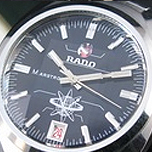
| Brand: | Rado |
| Model: | Marstron (standard version, black dial) |
| Ref.: | unknown |
| Issued: | ca. 1970 |
| Case: | Stainless steel with screw-back and inset medallion |
| Crystal: | glass with nine facets |
| Bracelet: | original steel with wide links and thin connectors |
| Movement: | ESA 9154 Dynotron - 13-jewel battery-powered electro-mechanical with balance wheel. Battery bridge signed "Rado" |
Description: As mentioned elsewhere on this site, this ca. 1970 model is another of several models Rado made that suggest a fascination with the "Space Race." This example features the rather rare black dial (as opposed to the silver or grey version) and globe-with-orbitals logo and printing of argent.
Present on this series is the rotating anchor logo previously seen only on watches with automatic winding. Hands are of varied widths of rectangles, with luminous filling, and the hours are indicated by wide hash marks--white lines denote the quarter-hour markers except at 6:00 where the date window is located (other dial colors feature orange or yellow accents). Case has off-set setting crown (signed), inset case back medallion typical of models seen in Japanese market, and faceted crystal. A less common example of this watch was also made; it features pointed hands and smaller, monochromatic hour markers. The dial of this watch sometimes appears to be blue, as shown in one of the photos below.
The Marstron with black dial is not often seen and was apparently made in smaller numbers than even the fairly uncommon grey version. A 1972 catalogue page showing the Marstron line includes three variants of this style, but not that with black dial.
Photos: Click for larger images
This model originally sold for 49,800 Yen, as indicated by period advertising and this photo of a new-old-stock watch.
This watch has been sold.
Note: More specific information pertaining to the manufacture/issue date of this watch is welcome. Please feel free to e-mail This email address is being protected from spambots. You need JavaScript enabled to view it..












